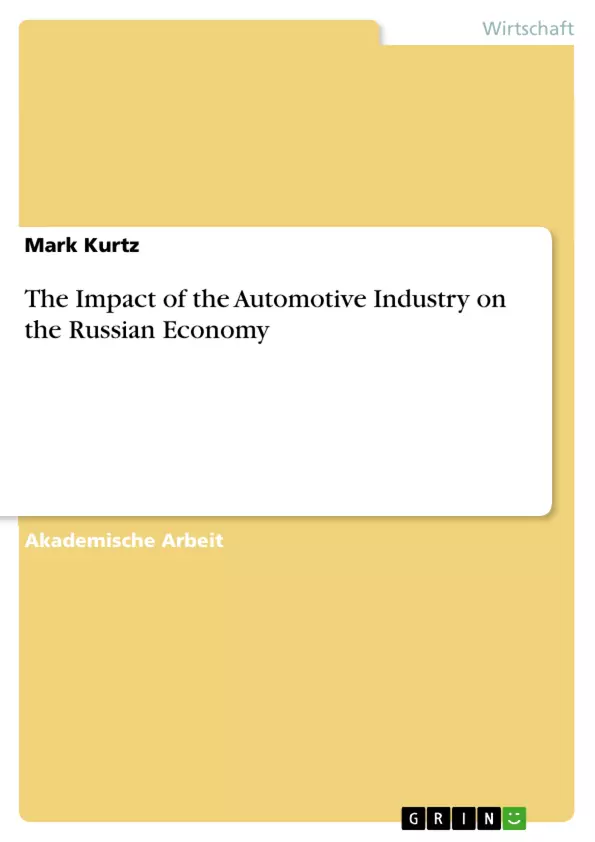The modern automotive industry is the leading branch of mechanical engineering in industrialized countries, influencing the processes of economic and social development of society. It gives impetus to the development of other
industries, stimulates the employment of the population both in the production of automotive equipment and its components, and in the maintenance of motor transport.
World experience shows that the presence of its own automotive industry is one of the main elements of ensuring national security. Automotive production is developing on the basis of the achievements of fundamental and applied science and being at the same time an important factor in scientific and technological progress. The automotive industry is the industry that is able to pull out all other industries. This is explained by its integrating role, since metallurgy, chemistry, electrical engineering, instrument making, light industry, etc. are connected with it in terms of supplies. In Russia, about 800 thousand people directly work in this industry, and in general - almost 10 % of the working-age population directly or indirectly work "for the car.
The aim of the work is to investigate the impact of the automotive industry on the Russian economy. The subject of the study is the peculiarities of the influence of the automotive industry on the Russian economy. To achieve a certain goal, the following tasks arise: to study the theoretical aspects of the automotive industry, to consider the automotive industry of foreign countries and to study the impact of the automotive industry on the economy of the Russian Federation.
The presented work uses federal laws and regulations of the Russian Federation regulating the automotive industry, materials published in periodicals, as well as Internet resources. Structurally, the work consists of an introduction, three chapters, a conclusion, a list of references.
Inhaltsverzeichnis
- 1. THEORETICAL ASPECTS OF THE AUTOMOTIVE INDUSTRY
- 2. AUTOMOTIVE INDUSTRY OF FOREIGN COUNTRIES
- 3. AUTOMOTIVE INDUSTRY OF RUSSIA
Zielsetzung und Themenschwerpunkte
Diese Arbeit zielt darauf ab, die Auswirkungen der Automobilindustrie auf die russische Wirtschaft zu untersuchen. Die Automobilindustrie als Objekt der Studie wird durch die besonderen Merkmale des Einflusses der Automobilindustrie auf die russische Wirtschaft als Forschungsgegenstand betrachtet. Um dieses Ziel zu erreichen, werden die folgenden Aufgaben verfolgt:
- Untersuchung der theoretischen Aspekte der Automobilindustrie,
- Betrachtung der Automobilindustrie in anderen Ländern,
- Studium der Auswirkungen der Automobilindustrie auf die Wirtschaft der Russischen Föderation.
Zusammenfassung der Kapitel
1. THEORETICAL ASPECTS OF THE AUTOMOTIVE INDUSTRY
Dieses Kapitel befasst sich mit dem Begriff, der Geschichte und der Bedeutung der Automobilindustrie für die Wirtschaft. Es werden auch die Probleme der Automobilindustrie untersucht.
2. AUTOMOTIVE INDUSTRY OF FOREIGN COUNTRIES
Dieses Kapitel befasst sich mit dem aktuellen Stand der Automobilindustrie in anderen Ländern, dem Umfang und der Verteilung des Automobilmarktes in anderen Ländern sowie mit der Prognose des Umfangs des Automobilmarktes in anderen Ländern.
3. AUTOMOTIVE INDUSTRY OF RUSSIA
Dieses Kapitel befasst sich mit dem aktuellen Stand der Automobilindustrie in der Russischen Föderation, den größten Unternehmen der Automobilindustrie der Russischen Föderation sowie den Besonderheiten des Einflusses der Automobilindustrie auf die Wirtschaft der Russischen Föderation.
Schlüsselwörter
Die wichtigsten Schlüsselwörter und Schwerpunktthemen dieser Arbeit umfassen: Automobilindustrie, russische Wirtschaft, Auswirkungen, theoretische Aspekte, internationale Automobilindustrie, Unternehmenslandschaft, Wirtschaftswachstum, Beschäftigung, Innovation, Nachhaltigkeit.
- Citar trabajo
- Mark Kurtz (Autor), 2020, The Impact of the Automotive Industry on the Russian Economy, Múnich, GRIN Verlag, https://www.grin.com/document/1185691



